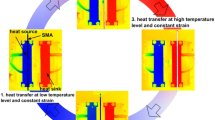Abstract
This work presents a study of the mechanical properties and influence of thermomechanical training conditions on the two-way shape-memory effect (TWSME) (magnitude and stability) in NiTi and NiTiCu alloys. Correlation with a stress-assisted two-way shape-memory effect (SATWSME) was also investigated. A rapid solidification technique was employed for preparation of small-dimension NiTi samples with homogeneous microstructure. Samples were fabricated by melt spinning. The melt-spun ribbons were trained under tensile deformation by thermal cycling through the phase transformation temperature range. Results showed that the tensile trainings under both constant strain and constant stress were effective in developing a TWSME. The SATWSME was comparable in magnitude to the TWSME. Addition of copper was effective in narrowing the transformation hysteresis and transformation temperature dependence on composition.

















Similar content being viewed by others
Notes
In Defdahl 10F 44141 Dortmund, Germany.
References
K. Wada, Y. Liu, Thermomechanical training and the shape recovery characteristics of NiTi alloys. Mater. Sci. Eng. A 481–482, 166–169 (2008)
Ch.Y. Chang, D. Vokoun, Ch.T. Hu, Two-way shape memory effect of NiTi alloy induced by constraint aging treatment at room temperature. Metall. Mater. Trans. A 32, 1629–1634 (2001)
M.J. Bigeon, M. Morin, Thermomechanical study of the stress assisted two way memory effect fatigue in TiNi and CuZnAl wires. Scripta Mater. 35, 1373–1375 (1996)
K. Wada, Y. Liu, On the mechanisms of two-way memory effect and stress-assisted two-way memory effect in NiTi shape memory alloy. J. Alloy. Compd. 449, 125–128 (2008)
K. Mehrabi, M. Bruncko, M. Härtel, A.C. Kneissl, Thermomechanical training and microstructure of NiTi melt-spun ribbons. Prakt. Met. Sonderbd. 41, 121–126 (2009)
Y. Liu, P.G. McCormick, Factors influencing the development of two-way shape memory in NiTi. Acta Metall. Mater. 38, 1321 (1990)
L.J. Chiang, C.H. Li, Y.F. Hsu, W.H. Wang, Effects of thermal cycling on multiple-stage transformation in Ti49.3Ni50.7 shape memory alloy. J. Alloys Compd. 462, 47–51 (2008)
R.D. Jean, J.C. Tsai, Effect of hot working on the martensitic transformation of Ni–Ti alloy. Scripta Metall. Mater. 30, 1027 (1994)
K. Mehrabi, M. Bruncko, A.C. Kneissl, Effect of thermomechanical training on the transformation temperatures and properties of NiTi melt-spun ribbons, ESOMAT, published by EDP Sciences, 06022 (2009)
R. Santamara, E. Cesari, J. Pons, T. Goryczka, Shape memory properties of Ni-Ti based melt-spun ribbons. Metall. Mater. Trans A 35A, 761–770 (2004)
Y. Tonga, Y. Liub, Effect of precipitation on two-way shape memory effect of melt-spun i50Ni25Cu25 ribbon. Mater. Chem. Phys. 120, 221–224 (2010)
J. Van Humbeeck, Damping properties of shape memory alloys during phase transformation. J. Phys. IV 6, 371–380 (1996)
K.C. Atli, I. Karaman, R.D. Noebe, D. Gaydosh, The effect of training on two-way shape memory effect of binary NiTi and NiTi based ternary high temperature shape memory alloys. Mater. Sci. Eng. A 560, 653–666 (2013)
K. Mehrabi, M. Bruncko, A.C. Kneissl, Microstructure, mechanical and functional properties of NiTi-based shape memory ribbons. J. Alloy. Compd. 526, 45–52 (2012)
K. Mehrabi, M. Bruncko, A.C. Kneissl, Investigation of bending trainings, transformation temperatures, and stability of two-way shape memory effect in NiTi-based ribbons. J. Mater. Eng. Perform. 22, 1443–1452 (2013)
C.M. Wayman, T.W. Duerig, Engineering Aspects of Shape Memory Alloys (Butterworth-Heineman Ltd., London, 1990), pp. 3–20
K.N. Melton, Engineering Aspects of Shape Memory Alloys (Butterworth-Heinemann Ltd., London, 1990), pp. 21–35
Author information
Authors and Affiliations
Corresponding author
Rights and permissions
About this article
Cite this article
Mehrabi, K., Kneissl, A.C. & Bruncko, M. Influence of Tensile Training Conditions on Shape-Memory Properties of NiTi-Based Ribbons. Metallogr. Microstruct. Anal. 3, 298–309 (2014). https://doi.org/10.1007/s13632-014-0154-4
Received:
Revised:
Accepted:
Published:
Issue Date:
DOI: https://doi.org/10.1007/s13632-014-0154-4




